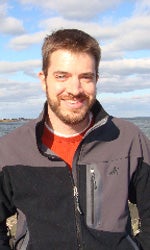Red Algal Adelphoparasites (NSF award #1257472)
Red algal parasites are ideal model organisms for investigating the origins of a parasitic life-style for two important reasons. First, most red algal parasites share an immediate common ancestor with an extant free-living red algal species, which is almost always their host, earning them the title adelphoparasites (adelphose is the Greek term for “kin”). Because of this sister-species relationship between parasite and host, a single pair of organisms can provide direct comparative data on the cellular and genomic changes occurring early in the evolution of a parasite, as well as information on host/parasite co-evolutionary dynamics. Second, hundreds of independently evolved red algal parasites have been described, all with varying degrees of divergence and relationship with their hosts, providing an enormous amount of comparative data with which to test mechanistic hypotheses. Red algal parasites have an unusual infection mechanism, whereby the unit of infection is the DNA-containing organelles of the parasite, rather than the entire organism. Because of this strange life history, this system further lends itself to understanding the principles behind such evolutionarily and medically relevant issues as the co-existence of two genomes in a cell (as in many endosymbioses) and the break down of self recognition factors, which are important in autoimmune diseases and the spread of cancer. Therefore, establishing red algal parasites as a model system for genomic study will produce broad-reaching data for years to come.
How does parasitism evolve at the lineage level?
Oomycetes are water moulds, rusts and plant pathogens that were once regarded as true fungi, but are now recognized to be members of the stramenopiles (also called heterokonts): a diverse lineage including both photosynthetic and non-photosynthetic members. In molecular phylogenies, a pattern of increasing virulence is apparent across the evolution of oomycetes. Early diverging members of the lineage are free-living saprobic decomposers, whereas species that diverge in the middle of the tree are mostly facultative pathogens. What the group is best known for, organisms like Phytophthora spp. that caused the Irish potato famine and Sudden Oak Death today, and obligate parasites that have evolved most recently. In collaboration with Dr. Craig Bailey (UNC Wilmington), we are investigating how parasitism evolved in the oomycete lineage, using a comparative genomic approach.
The Bermuda Seaweed Project (NSF award #1120652)
In collaboration with Dr. Craig Schneider (Trinity College), the Lane lab is also involved in The Bermuda Seaweed Project, located in Bermuda. The islands of Bermuda are ideally located for marine biodiversity assessment studies, because the isolated archipelago is at the interface of tropical and warm temperate biogeographic zones. Despite its distant location from North America and its tropical summer temperatures, Bermuda’s small size at present supports only ca. 450 species of red, brown and green seaweeds, and endemism among these groups is reportedly less than 3%. The small size of the total flora make it possible to completely assess this archipelago’s algal diversity over a short time period; a project that would be near impossible for larger-sized, and more diversely populated, islands in the Caribbean. Additionally, based on work done by the Drs. Lane and Schneider over the last decade, a significant number of Bermuda’s algal species have already been shown to have misapplied misapplied binomials, based on European heterospecifics. Molecular assessment of all Bermuda species will both continue to uncover numerous cryptic species and identify cases of misnamed taxa, thereby increasing the level of endemisms in these islands and the accuracy of biodiversity assessments.
The Rhode Island Seaweed Project
During the 2012-2013 we will be additionally assessing the marine flora of Rhode Island as part of a joint RI STAC grant with Dr. Brian Wysor at Roger Williams University.
 Home
Home Browse
Browse Close
Close Events
Events Maps
Maps Email
Email Brightspace
Brightspace eCampus
eCampus



